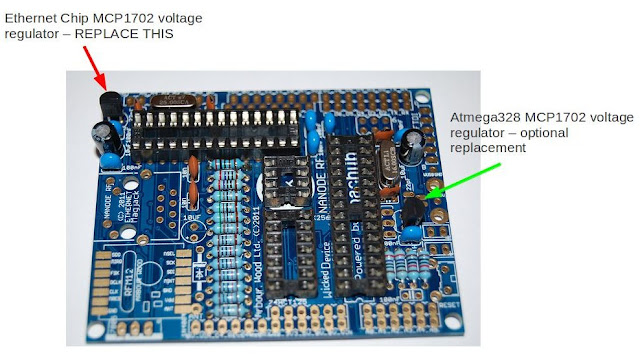Faulty Batch of MCP1702 Voltage Regulators
Many people were getting the message "Failed to access Ethernet controller" when running an EtherCard example.
After much testing we have identified the problem. It turns out that the MCP1702 3.3V voltage regulator which supplies 3.3V to the Ethernet Chip (ENC28J60) was not supplying enough current to power the chip. The voltage was dropping down to 2.6V under load.
Swapping the voltage regulator for one from a different batch solved the problem. it looks like we have been sent a faulty batch of voltage regulators, our apologies for not spotting this sooner.
Note: this problem only applies to the MCP1702 voltage regulators in the latest batch of Nanode RF kits. All emonTx and emonGLCD kits are un-effected, they have always used regulators from another source.
If you have this problem we will send out two replacement regulators free of charge, one for the Ethernet chip and the other for powering the Atmega 328, it may be ok to leave the Atmega328 voltage regulator in place as the current requirements are not as high and it seems to work fine here without swapping it out, but we will send two out so that you can swap out as you prefer.
All the Nanode RF's kits sold through the shop from today onwards will contain the non-faulty voltage regulators.
De-soldering tips
The easiest way to de-solder the regulator is to if possible cut two of the regulator legs, you can then pull out the third by pulling on the regulator body itself while holding the soldering iron tip on the solder surrounding the leg. Then use pliers to pull out the other legs one by one. It is usually easier to pull the legs out if there is actually plenty of (molten) solder around the leg. To clear the holes of solder with a solder sucker again make sure there is plenty of solder in the holes to start with, this usually leaves the cleanest result in our experience. An extra pair of hands can help make the whole job easier.
To engage in discussion regarding this post, please post on our Community Forum.

